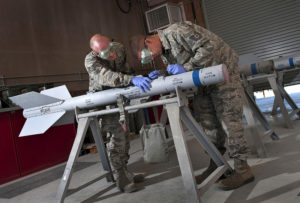
Staff Sgt. Daniel Manzer, left, and Tech. Sgt. Jonathan Kidd work on an AIM-9 Sidewinder missile during exercise Green Flag-West 13-02 at Nellis Air Force Base, Nev., Nov. 2, 2012. (U.S. Air Force photo by Val Gempis)
By now you have heard about how a US F/A-18E Super Hornet downed a Syrian Su-22 fighter jet on June 18th. The news spread around media outlets like wildfire as it was the first manned aircraft downed by the US since 1999.
Once the smoke cleared we learned the Su-22 “Fitter”, a 30-year-old Cold War era jet, somehow managed to evade the US military’s most advanced short range air-to-air missile, the infrared guided AIM-9x Sidewinder missile designed to resist the allure of defensive flares. The Su-22 apparently used “dirty” flares to lure away the Sidewinder. Although the Syrian Su-22 jet eventually met its demise at the hands of a radar guided AIM-120 AMRAAM medium range missile, it is still unknown how exactly the Syrian jet was able to fend off the AIM-9x Sidewinder. Kyle Mizokami of Popular Mechanics writes about how and why the AIM-9X may have missed its target.
[a] Super Hornet…is the U.S. Navy’s top-of-the-line strike fighter. The Super Hornet is armed with both the infrared guided AIM-9X Sidewinder short range air-to-air missile and the radar-guided AIM-120 AMRAAM medium-range missile. It’s a potent combination of air-to-air missiles, representing the best of American military technology.
According to CNN, the Navy Super Hornet locked onto the Su-22 Fitter at a range of 1.5 miles. The Super Hornet launched an AIM-9X, and the Syrian pilot loosed flares to lure the infrared guided missile away from his fighter. The trick worked, and the American missile missed. The Super Hornet then launched an AMRAAM missile which, using radar guidance, is unaffected by flares. This time the Fitter went down.
So why did the AIM-9X miss? A contributor to Combat Aircraft magazine proposed a plausible theory: While the 9X is designed to resist the allure of defensive flares, but it may have been too specialized in rejecting American flares. Contributor Angad Singh tweeted a story originally written by aviation authority Bill Sweetman about American tests of Soviet aircraft during the Cold War.
During the 1980s, U.S. Air Force maintained the top secret 4477th Test & Evaluation Squadron. Flying the Tonopah Test Range in Nevada, the 4477th operated Soviet fighters collected from around the world, often captured by allies, to determine their capabilities. According to the story, the Air Force received a flare dispenser that had been on a Su-25 ground attack jet shot down over Afghanistan. The dispenser was quickly attached to a MiG-21 operated by the 4477th and taken out for testing against the latest American infra-red guided missile, the AIM-9P.
What happened next surprised the Air Force. The AIM-9P Sidewinder, designed to see past flares, was readily diverted by the Soviet flares. The problem was that the -9P was too attuned to the characteristics of American flares it had been tested against and not against the Soviet flares, which according to the squadron commander between 1985 and 1987 were “dirty, and none of them looked the same.”
Read the full article here.
During the Taiwan Strait battles in 1958, it’s believed an AIM-9 Sidewinder was fired at a PLAAF MiG-17 hitting its target without exploding. The MiG-17 was able to land with the Sidewinder lodged in the airframe. The missile was then turned over to Soviet engineers who would reverse engineer a copy of the Sidewinder, substantially improving the Soviets’ air to air combat capabilities. Any additional defensive measures the Russians learned from the missile capture may have come to light in the Syrian skies.
The “dirty” flares, coupled with digital radio frequency jamming could spell trouble for the new F-35 Joint Strike Fighter. The F-35, not designed for dogfights, is due to get the latest Block 3F software integration later this year, allowing it to carry the AIM-9X Sidewinder. Like the AIM-9X, the F-35’s AIM-120 AMRAAM medium range air-to-air missile—which allows the F-35 to engage enemy aircraft at a safe distance—could also be affected by the jammers. Dave Majumdar of The National Interest writes, “If forced into a dogfight the F-35 pilot’s skills and experience” may be his or her only advantage.
Unlike a Raptor, which was designed from the outset as an air-to-air killer par excellence—the F-35 was not. The Raptor combines a very stealthy airframe with a high altitude ceiling and supersonic cruise speeds in excess of Mach 1.8. Compared to that, the F-35 can just barely touch Mach 1.6 in full afterburner. Further, the F-22 possesses excellent maneuverability for close-in visual-range dogfights––it crushes the competition in terms of turn rate, radius, angle-of-attack and energy addition at all altitudes.
Whereas a four-ship flight of Raptors cruising at high supersonic speeds in the rarified atmosphere above 50,000 feet can effectively choose when and where to fight, a flight of slower, lower-flying F-35s might find themselves forced to react to better-performing enemy planes if they are not careful.
Moreover, the F-35 does not have the speed or altitude to impart as much launch energy to the AIM-120 air-to-air missile as the Raptor can, which means the missiles will have less range when fired from a JSF. Nor can the F-35 carry as many air-to-air missiles—which is a problem given that digital radio frequency memory jammers can wreak havoc with the AMRAAM’s guidance system.
Close in, the JSF does not have the maneuverability of the Raptor––or even a F-16 or F/A-18. If forced into a dogfight, an American F-35 pilot’s superior skills and experience might be the only factor that might save him or her from being shot down. The fact is that an F-35 in stealthy configuration armed only with internal weapons cannot currently carry the AIM-9X high off-boresight missile. If the AIM-9X were one day integrated into the weapons bays, it would come at the cost of an AIM-120 rail—which is arguably a better weapon for an aircraft like the F-35. Basically, an F-35 pilot should avoid a close in fight at all costs.
Read the full article here.
E.J. Smith - Your Survival Guy
Latest posts by E.J. Smith - Your Survival Guy (see all)
- Rule #1: Don’t Lose Money - April 26, 2024
- How Investing in AI Speaks Volumes about You - April 26, 2024
- Microsoft Earnings Jump on AI - April 26, 2024
- Your Survival Guy Breaks Down Boxes, Do You? - April 25, 2024
- Oracle’s Vision for the Future—Larry Ellison Keynote - April 25, 2024















